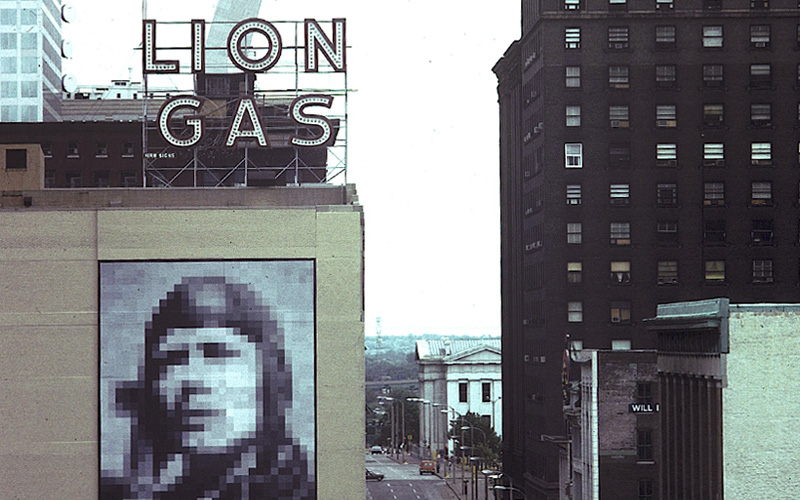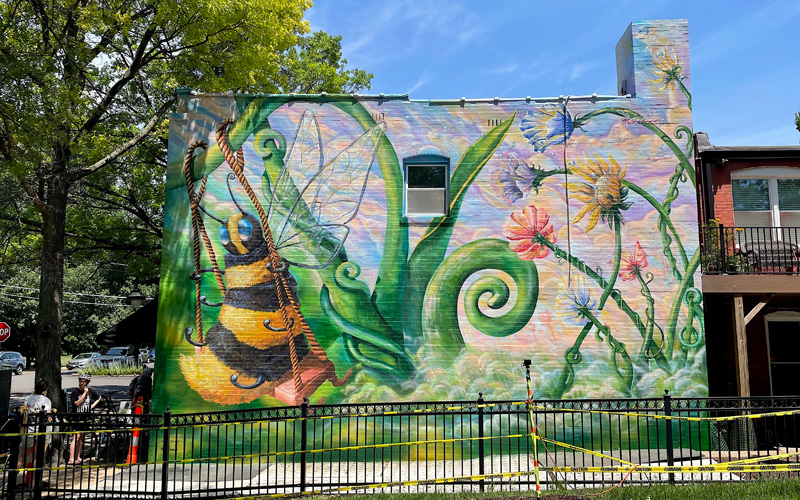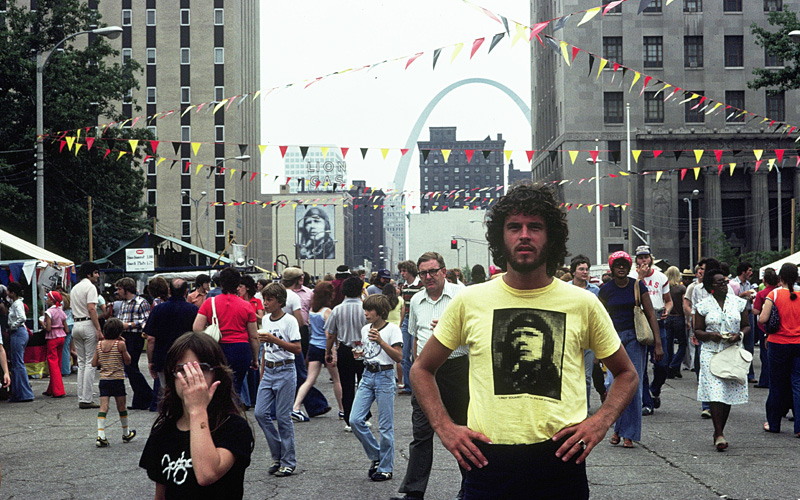By Kallie Cox
If you’ve ever set foot in the city, chances are you’ve seen a masterpiece created by the mural family of St. Louis.
Robert Fishbone, a 2016 and 2018 Regional Arts Commission Grant Recipient, founded On the Wall Productions fifty years ago with his late wife Sarah Linquist. The couple created stunning and historic murals all over the city, most of which have since been lost to changes in the urban environment.
The couple made it their mission to beautify the city by transforming ordinary walls into works of art.
Fishbone and Linquist had an unusual start in their mural career. They were originally invited to St. Louis to start a community video center. When they realized they weren’t making any money in the video business, they began delivering a newspaper.
“We read an article that the city — at the time the St. Louis Beautification Commission — was interested in seeing more murals downtown,” Fishbone said. The organization picked one of their designs and told them they could get to work.
Fishbone, Linquist, and about 23 of their friends painted a 6,000 square foot, four-panel sequence of a butterfly emerging from its cocoon.
“What it shows is transformation, metamorphosis is the scientific term. So how something beautiful can come out of something ordinary or plain,” Fishbone said. “St. Louis was doing all different kinds of renovation, restoration, revitalization, so the [butterfly] became kind of a symbol for that.”
When they finished the first mural, they still weren’t thinking of themselves as professionals, Fishbone said.
But then they got another job painting a mural in exchange for a V.W. car. As more jobs began to trickle in, Linquist and Fishbone became hooked on the art form. A grant from the NEA, supported by the city and multiple small businesses and neighborhood organizations funded them to do five murals in 1976 across St. Louis. This then solidified their place as full time mural makers.
“Because we see ourselves as problem solvers as much as artists, all of our work is site specific; in fact you wouldn’t even know that all of the work we’ve done was by the same artists. Reflecting this, our process has always remained the same”, says Fishbone. “Standing with my back to the wall, I want to see what the wall sees, what the wall has witnessed over time. Who lives and works here? Is there a rich history? What activities happen? Are there aspirations or a mission that could be addressed in a unique and colorful way? This all figures into our design process.”
At first, these projects took the form of 2D artwork as the couple continued to hone their craft. Then, they got curious.
Fishbone wanted to answer a question from a Scientific American article that piqued his interest: How little information do you need to recognize someone’s face?
“Even though there were no computers, no Photoshop, there were pixels. So how small do the pixels have to be, and how many do you need to suddenly be able to recognize someone’s face?” Fishbone said.
They teamed up with an individual who had a machine that could project a picture on one side, and on the other would be hundreds of shades of gray or colored pixels that when put together, would reveal the image.
“We used this process where we measured light reflectance, and zero would be black, 100 would be pure white. We ended up with 72 shades of gray, and 1200 squares,” Fishbone said.
This experiment led to the creation of their most famous mural, a 30’ by 40’ portrait of Charles Lindbergh in downtown St. Louis. They dubbed it “Lindy Squared.”

Photo courtesy of On The Wall Productions
The mural was only up for four years before the building was torn down, but it became somewhat of a landmark in the city, he said.
After Fishbone and Linquist had kids, they realized they needed other forms of income. So, they began to create a line of products that could be sold in museum gift shops.
Their first product — a four-foot-tall, three-dimensional inflatable of the figure from the famous painting “The Scream” — was a wild success.
“Over time, we sold, between that and a smaller one, almost half a million in 20 different countries,” Fishbone said. “Our line of products ended up being close to 200 different items, all quirky!”
Around the time Fishbone was focusing on the product line, Linquist became the head of the scenic art department at the Muny. The couple continued to produce murals throughout the year until Linquist passed away in 2010 and Fishbone’s passion for murals faded.
Like father like daughter
Robert Fishbone’s interest would be reawakened in 2015 by his daughter, Liza Fishbone.
“I got into murals through my family. I grew up around it. I never intended to go that direction, but it was very much a big part of my childhood, it was our normal,” Liza said. “Then I came back to St Louis a little bit after college and was trying to figure out what to do, and saw this call for a mural, and I was like, ‘Dad, you want to do one?’ So that’s kind of how I got into it, and we got that commission and yeah, so now I’ve been doing it for almost 10 years.”
The mural that launched Liza Fishbone’s career in murals was part of a “66 Things to Love About St. Louis” challenge and they painted a colorful mural with lots of movement on the side of the KDHX building, incorporating symbols of St. Louis.
Working on the project with her dad was like going to mural grad school, Liza Fishbone said. But this isn’t the piece she likes to focus on.
Her favorite mural is a St. Louis project she also did with her father adjacent to a children’s park in DeMun. It depicts a giant bee on a swing set surrounded by fantasy flowers. To this day, Liza Fishbone said she receives texts from community members about their visits to “Bubbles” — the bee.

Photo courtesy of On The Wall Productions
Liza Fishbone also spent several years restoring nine of her mother’s murals originally done from 1996-2005 for Willert Home Products at 39th and Park. Fishbone adds: “Bill Willert has been very invested in not just making his own corporate campus beautiful, he is a behind the scenes contributor to the surrounding neighborhoods. He is the kind of role model, supporting the arts, that we need more of in our business community. ”
Over the years, she unlocked new styles and skills, but her favorite things to create are fantasy landscapes inspired by the spaces and cities they are in.
“I’ve been making fantasy landscapes for a long time. I’ve been developing it more seriously in the past several years and I love making characters,” she said. “They can often represent something, or sometimes a character as something that’s not human is easier to relate to than a human is.”
Now, Liza Fishbone is based in Austin Texas, and has turned her talents to immersive art, she said. Her current project is for the Lady Bird Johnson Wildflower Center and is a butterfly airplane that children can play inside.
While Liza Fishbone came into the mural world in an unusual way because of her parents, she has advice for young people looking to do the same.
“Try to connect with an artist in your local area that you’re interested in and just […] take them out to coffee, ask them questions, and then develop a relationship,” Liza Fishbone said. “Then see if you can observe them or help them.”
Robert Fishbone gave the same advice as his daughter.
“Trying to figure all this out [by] yourself is really difficult — I mean, it’s not that hard. You find a wall, you paint on it — But, […] if you want to get into big murals like we do, it’s way more complicated”.
More than Murals
Both Fishbones have branched out from their early mural days. For Liza, this means creating interactive fantasy worlds.
“I, one day, want to have my own immersive Wonderland,” she said. “But a dream project that I would love is if I could build a fantasy world for Craft Jet-Puffed Marshmallows because that’s my favorite food, I think that would be amazing.”
Robert Fishbone has completed over 200 very diverse, public art projects, he said. But his artistic interests have never been confined to that medium.
Following his wife’s death, Robert Fishbone took up drumming.
He taught drumming circles and team building to groups, including non-profits and those in prison. He also wrote a book “Selling the Scream” and toured colleges around the country teaching workshops about The Good, The Bad and The Ugly of being an artist entrepreneur.
Around the time Robert Fishbone began painting murals with his daughter, he also developed a fascination with meditation labyrinths. These are similar to mazes, except that there is only one path that takes a person to the labyrinth’s center. The goal of this is to create a calming, mindful experience that allows for meditation and prayer. So far, he has created five of these, and he is currently working on his most ambitious one for the Bellefontaine Cemetery and Arboretum, he said.
So what brings him back to murals time after time?
“I like working with a variety of people,” he said. “I favor art as a very effective way of transforming the urban environment, and frankly, I also love being able to work outdoors on big, complex projects.”
Summing it up, Robert Fishbone said his murals have the same goals:
“To be uplifting, to be engaging, to add beauty, and to surprise!”
Kallie Cox is a former staff writer at the Riverfront Times. They began writing freelance content for the Regional Arts Commission of St. Louis in June 2024.


Follow Us On Social Media